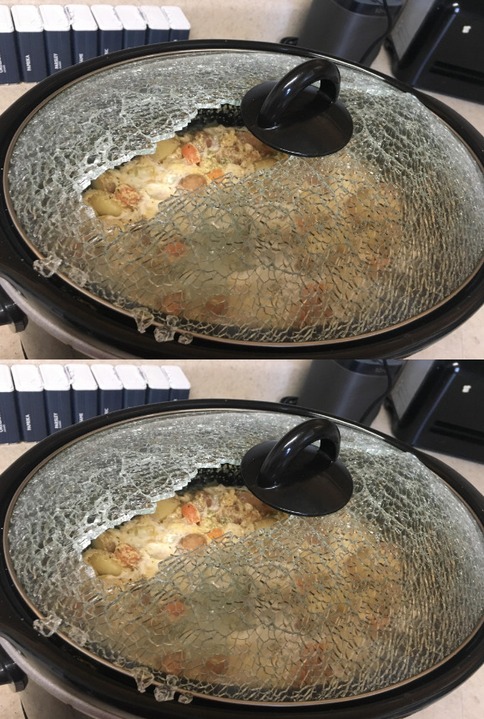Arguably, a crockpot is one of the most useful and versatile kitchen appliances and gadgets. They make large meals that take all day to cook, simultaneously eliminating the need for several pots and pans per meal. However, a warning has been issued by a mom who recently had a scare, sending her and her children into a panic.
Warning About Crockpot Safety

The woman posted a picture of her damaged crockpot on Facebook, warning others not to make the same mistake. According to the woman’s post, the picture shows her stove covered in 15-bean chili soup. She explained that it hadn’t fully cooked, after “6 hours on high.” As a result, she put the crockpot on the stove to cook for an additional hour.
A Crockpot Mess

However, something odd happened when she lifted the crockpot off the stove after it had cooled. The bottom of the crockpot fell off, sticking to the stovetop. Unsurprisingly, the people of Facebook were happy to point out her error. Some helpfully noted that a crockpot shouldn’t be hotter than 400 degrees Fahrenheit, while others pointed out that the manual warns against using the crockpot on the stove or berated her mistake. Lastly, a few came to her rescue, pointing out that she made a mistake and everyone does sometimes.
Ceramic can be Delicate

You shouldn’t put a crockpot on the stove to cook because they aren’t designed to withstand high temperatures. Instead, a crockpot is made of ceramic and designed for low heat over a long period. Alternatively, a stovetop heats up quickly and can cause damage to the crockpot, or danger to your family.
Dangers of the Crockpot on the Stovetop

The ceramic insert can easily crack or break when exposed to rapid and high temperatures. As a result, your crockpot likely won’t withstand the heat like the woman from Facebook. However, chips, cracks, and messes aren’t the only possible harm from cooking with a crockpot on the stove. They may shatter or explode, sending shards of ceramic barreling toward loved ones, and pets, or hidden on the floor and in rugs, causing cuts and injuries. Additionally, cooking with a crockpot on the stove can lead to electrical issues and hazards.
General Rules of Ceramic Kitchenware

Noting that the crockpot’s ceramic insert is the problem may lead to an important question regarding kitchen safety. Are there ceramic dishes that are safe for stovetop cooking? In short, no. A general rule of thumb is to avoid putting ceramic on the stovetop to cook, in some cases this rule may even extend to the microwave and dishwasher. However, some brands carry special lines of ceramic cookware that have been treated for high heat. Fortunately, the manufacturer’s guidelines should offer insight as to whether or not that is the case. Moreover, most dish sets have print on the bottom specifying if they should be hand-washed or can be used in the oven, microwave, or stove.
Other Dish Options

While ceramic dishes are often finely crafted and aesthetically pleasing, they’re also more high maintenance than other materials. Here are some easier alternatives:
- Glass. However, it’s important to note that glass can shatter if hot and placed on a cold surface like the counter or in the fridge.
- Manufacturers like Corningware and Pyrex.
- Silicone. Although it can withstand temperatures of up to 500 degrees Fahrenheit, silicone shouldn’t be used to exceed that temperature, or if it’s damaged, warped, or cut.
- Stainless Steel.
- Cast Iron. Note the handles can cause severe burning so it’s always recommended to use a pot holder, or a silicone handle, if not both.
Top Cookware Choices

Furthermore, Spruce Eats reviewed more than 130 cookware sets and narrowed down some crowd favorites for 2024. Some of their top choices for design, functionality, and ease of use include All-Clad, Farberware, Lagostina Martellata Hammered Copper Pans, and Caraway.
Although many instinctively know that cooking with a crockpot on the stove isn’t safe, numerous other safety concerns loom in the kitchen. Dangers that often go unnoticed or thought of, until it’s too late. As such, it’s always best to follow the safety guidelines and thoroughly research how to use certain products, particularly where fire or electricity are involved.
